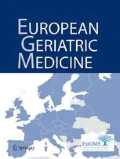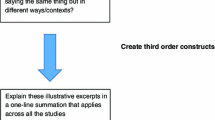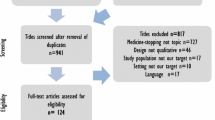Key Summary Points
To describe the objectives and expected impact of an international consortium (iKASCADE) whose purpose is to improve drug safety for older adults by addressing prescribing cascades through a sex and gender lens.
AbstractSection FindingsThe consortium proposes to (a) develop an inventory of clinically relevant prescribing cascades; (b) provide a detailed understanding of sex-specific prescribing cascades in hospital, long-term care, and community settings; (c) foster a greater understanding of similarities or differences regarding prescribing cascades internationally; (d) and provide a nascent understanding of the ways in which gender dimensions may influence the development or treatment of prescribing cascades.
AbstractSection MessageIt is critically important to examine sex and gender within geriatric pharmacology to better inform recommendations and treatment decisions tailored for older women and men.
Abstract
Purpose
To describe the objectives, methods and expected impact of an international consortium (iKASCADE) whose purpose is to improve drug safety for older adults by addressing prescribing cascades through a sex and gender lens.
Methods
To create a comprehensive, internationally relevant inventory of prescribing cascades affecting older adults, the consortium has created a modified Delphi procedure where international experts in prescribing and managing pharmacotherapy for older adults will rank a list of prescribing cascades as to their clinical importance. We will use administrative and clinical data on older adults to evaluate the frequency of prescribing cascades by sex internationally, in the hospital, long-term care and community settings. Finally, we will use semi-structured interviews and realistic, country-specific vignettes, each incorporating a prescribing cascade with identified sex differences, to explore how socially constructed gender roles contribute to the experience, presentation and management of prescribing cascades.
Results
The consortium will synthesize the quantitative and qualitative results to produce a position paper and products—aimed at knowledge users within and outside of academia—designed to elevate the importance of integrating a gender dimension in the identification and prevention of prescribing cascades.
Conclusion
Findings will improve our understanding of how adverse drug events are different between older women and men and inform the development and dissemination of tailored knowledge translation products to reduce the frequency and impact of prescribing cascades.

Similar content being viewed by others
Availability of data and material
Additional information about the iKASCADE Team and project is available from the corresponding author.
References
Gutiérrez-Valencia M, Martínez-Velilla N, Vilches-Moraga A (2019) Polypharmacy in older people: time to take action. Eur Geriatr Med 10(1):1–3. https://doi.org/10.1007/s41999-018-0140-5
Duerden M, Avery T, Payne R. Polypharmacy and medicines optimisation - Making it safe and sound. The King's Fund 2013 https://www.kingsfund.org.uk/sites/files/kf/field/field_publication_file/polypharmacy-and-medicines-optimisation-kingsfund-nov13.pdf. Accessed 29 Sept 2020
World Health Organization (2017) Medication without harm—global patient safety challenge on medication safety. Geneva. Licence: CC BY-NC-SA 3.0 IGO. https://apps.who.int/iris/rest/bitstreams/1083775/retrieve. Accessed 25 Mar 2021
Scottish Government Polypharmacy Model of Care Group (2018) Polypharmacy Guidance, Realistic Prescribing, 3rd edn. Scottish Government. https://www.therapeutics.scot.nhs.uk/wp-content/uploads/2018/04/Polypharmacy-Guidance-2018.pdf. Accessed 25 Mar 2021
Rochon PA, Gurwitz JH (2017) The prescribing cascade revisited. Lancet (Lond Engl) 389(10081):1778–1780. https://doi.org/10.1016/S0140-6736(17)31188-1
Brath H, Mehta N, Savage RD, Gill SS, Wu W, Bronskill SE et al (2018) What is known about preventing, detecting, and reversing prescribing cascades: a scoping review. J Am Geriatr Soc 66(11):2079–2085. https://doi.org/10.1111/jgs.15543
Masnoon N, Shakib S, Kalisch-Ellett L, Caughey GE (2017) What is polypharmacy? A systematic review of definitions. BMC Geriatr 17(1):230. https://doi.org/10.1186/s12877-017-0621-2
Gutiérrez-Valencia M, Izquierdo M, Cesari M, Casas-Herrero Á, Inzitari M, Martínez-Velilla N (2018) The relationship between frailty and polypharmacy in older people: a systematic review. Br J Clin Pharmacol 84(7):1432–1444. https://doi.org/10.1111/bcp.13590
Leelakanok N, Holcombe AL, Lund BC, Gu X, Schweizer ML (2017) Association between polypharmacy and death: a systematic review and meta-analysis. J Am Pharm Assoc JAPhA 57(6):729-738.e10. https://doi.org/10.1016/j.japh.2017.06.002
Fried TR, O’Leary J, Towle V, Goldstein MK, Trentalange M, Martin DK (2014) Health outcomes associated with polypharmacy in community-dwelling older adults: a systematic review. J Am Geriatr Soc 62(12):2261–2272. https://doi.org/10.1111/jgs.13153
Maher RL, Hanlon J, Hajjar ER (2014) Clinical consequences of polypharmacy in elderly. Expert Opin Drug Saf 13(1):57–65. https://doi.org/10.1517/14740338.2013.827660
Palmer K, Villani ER, Vetrano DL, Cherubini A, Cruz-Jentoft AJ, Curtin D et al (2019) Association of polypharmacy and hyperpolypharmacy with frailty states: a systematic review and meta-analysis. Eur Geriatr Med 10(1):9–36. https://doi.org/10.1007/s41999-018-0124-5
Guthrie B, Makubate B, Hernandez-Santiago V, Dreischulte T (2015) The rising tide of polypharmacy and drug-drug interactions: population database analysis 1995–2010. BMC Med 13(1):74. https://doi.org/10.1186/s12916-015-0322-7
Midão L, Giardini A, Menditto E, Kardas P, Costa E (2018) Polypharmacy prevalence among older adults based on the survey of health, ageing and retirement in Europe. Arch Gerontol Geriatr 78:213–220. https://doi.org/10.1016/j.archger.2018.06.018
Onder G, Liperoti R, Fialova D, Topinkova E, Tosato M, Danese P et al (2012) Polypharmacy in nursing home in Europe: results from the SHELTER study. J Gerontol A Biol Sci Med Sci 67(6):698–704. https://doi.org/10.1093/gerona/glr233
Guthrie B, Payne K, Alderson P, McMurdo ME, Mercer SW (2012) Adapting clinical guidelines to take account of multimorbidity. BMJ (Clin Res Ed) 345:e6341. https://doi.org/10.1136/bmj.e6341
Rochon PA, Gurwitz JH (1997) Optimising drug treatment for elderly people: the prescribing cascade. BMJ (Clin Res Ed) 315(7115):1096–1099
Rochon PA, Gurwitz JH (1995) Drug therapy. Lancet (Lond Engl) 346(8966):32–36
McCarthy LM, Visentin JD, Rochon PA (2019) Assessing the scope and appropriateness of prescribing cascades. J Am Geriatr Soc 67(5):1023–1026. https://doi.org/10.1111/jgs.15800
Piggott KL, Mehta N, Wong CL, Rochon PA (2020) Using a clinical process map to identify prescribing cascades in your patient. BMJ (Clin Res Ed) 368:m261. https://doi.org/10.1136/bmj.m261
Gill SS, Mamdani M, Naglie G, Streiner DL, Bronskill SE, Kopp A et al (2005) A prescribing cascade involving cholinesterase inhibitors and anticholinergic drugs. Arch Intern Med 165(7):808–813. https://doi.org/10.1001/archinte.165.7.808
Savage RD, Visentin JD, Bronskill SE, Wang X, Gruneir A, Giannakeas V et al (2020) Evaluation of a common prescribing cascade of calcium channel blockers and diuretics in older adults with hypertension. JAMA Intern Med. https://doi.org/10.1001/jamainternmed.2019.7087
Hill-Taylor B, Sketris I, Hayden J, Byrne S, O’Sullivan D, Christie R (2013) Application of the STOPP/START criteria: a systematic review of the prevalence of potentially inappropriate prescribing in older adults, and evidence of clinical, humanistic and economic impact. J Clin Pharm Ther 38(5):360–372. https://doi.org/10.1111/jcpt.12059
Watson S, Caster O, Rochon PA, den Ruijter H (2019) Reported adverse drug reactions in women and men: aggregated evidence from globally collected individual case reports during half a century. EClinicalMedicine 17:100188. https://doi.org/10.1016/j.eclinm.2019.10.001
Alturki A, Alaama T, Alomran Y, Al-Jedai A, Almudaiheem H, Watfa G (2020) Potentially inappropriate medications in older patients based on Beers criteria: a cross-sectional study of a family medicine practice in Saudi Arabia. BJGP Open. 4:bjgpopen20X101009. https://doi.org/10.3399/bjgpopen20X101009
Rydberg DM, Mejyr S, Loikas D, Schenck-Gustafsson K, von Euler M, Malmström RE (2018) Sex differences in spontaneous reports on adverse drug events for common antihypertensive drugs. Eur J Clin Pharmacol 74(9):1165–1173. https://doi.org/10.1007/s00228-018-2480-y
Sørup FKH, Eriksson R, Westergaard D, Hallas J, Brunak S, Ejdrup AS (2020) Sex differences in text-mined possible adverse drug events associated with drugs for psychosis. J Psychopharmacol (Oxf Engl) 34(5):532–539. https://doi.org/10.1177/0269881120903466
Whitley H, Lindsey W (2009) Sex-based differences in drug activity. Am Fam Phys 80(11):1254–1258
Mattison D (2013) Pharmacokinetics in real life: sex and gender differences. J Popul Ther Clin Pharmacol 20(3):e340–e349
Zucker I, Prendergast BJ (2020) Sex differences in pharmacokinetics predict adverse drug reactions in women. Biol Sex Differ 11(1):32. https://doi.org/10.1186/s13293-020-00308-5
Jacobson R (2014) Psychotropic drugs affect men and women differently. Sci Am Mind. https://www.scientificamerican.com/article/psychotropic-drugs-affect-men-and-women-differently. Accessed 25 Mar 2021
Miller MA (2001) Gender-based differences in the toxicity of pharmaceuticals–the food and drug administration’s perspective. Int J Toxicol 20(3):149–152. https://doi.org/10.1080/109158101317097728
United States General Accounting Office (2001) Drug safety: most drugs withdrawn in recent years had greater health risks for women. https://www.gao.gov/assets/gao-01-286r.pdf. Accessed 25 Mar 2021
Vitale C, Fini M, Spoletini I, Lainscak M, Seferovic P, Rosano GM (2017) Under-representation of elderly and women in clinical trials. Int J Cardiol 232:216–221. https://doi.org/10.1016/j.ijcard.2017.01.018
McCormick A, Fleming D, Charlton J (1995) Morbidity Statistics from General Practice. Fourth national study 1991–1992. OPCS Series MB5 no.3. London: HMSO1995
Mauvais-Jarvis F, Bairey Merz N, Barnes PJ, Brinton RD, Carrero JJ, DeMeo DL et al (2020) Sex and gender: modifiers of health, disease, and medicine. Lancet (Lond Engl) 396(10250):565–582. https://doi.org/10.1016/s0140-6736(20)31561-0
Regitz-Zagrosek V (2012) Sex and gender differences in pharmacology. Springer, Berlin
Lega IC, Bronskill SE, Campitelli MA, Guan J, Stall NM, Lam K et al (2019) Sodium glucose cotransporter 2 inhibitors and risk of genital mycotic and urinary tract infection: a population-based study of older women and men with diabetes. Diabetes Obes Metab 21(11):2394–2404. https://doi.org/10.1111/dom.13820
Savage RD, Visentin JD, Bronskill SE, Wang X, Gruneir A, Giannakeas V et al (2020) Evaluation of a common prescribing cascade of calcium channel blockers and diuretics in older adults with hypertension. JAMA Intern Med 180(5):643–651. https://doi.org/10.1001/jamainternmed.2019.7087
Dalton K, Curtin D, O’Mahony D, Byrne S (2020) Computer-generated STOPP/START recommendations for hospitalised older adults: evaluation of the relationship between clinical relevance and rate of implementation in the SENATOR trial. Age Ageing 49(4):615–621. https://doi.org/10.1093/ageing/afaa062
ICES. ICES Data. https://www.ices.on.ca/Data-and-Privacy/ICES-data. Accessed 25 Mar 2021
Maccabi. https://www.ksminnovation.com/maccabitech. Accessed 25 Mar 2021
Morgan R, George A, Ssali S, Hawkins K, Molyneux S, Theobald S (2016) How to do (or not to do)… gender analysis in health systems research. Health Policy Plan 31(8):1069–1078. https://doi.org/10.1093/heapol/czw037
Jhpiego. Gender Analysis Toolkit for Health Systems (2016). https://gender.jhpiego.org/analysistoolkit/introduction. Accessed 25 Mar 2021
European Network to Reduce vulnerabilities in health. Legal report on access to healthcare in 16 European countries (2017). https://mdmeuroblog.wordpress.com/resources/publications
Horizon 2020 Programme (2016) Guidelines on FAIR Data Management in Horizon 2020. https://ec.europa.eu/research/participants/data/ref/h2020/grants_manual/hi/oa_pilot/h2020-hi-oa-data-mgt_en.pdf. Accessed 25 Mar 2021
Day S, Mason R, Tannenbaum C, Rochon PA (2017) Essential metrics for assessing sex & gender integration in health research proposals involving human participants. PLoS ONE 12(8):e0182812. https://doi.org/10.1371/journal.pone.0182812
Acknowledgements
The authors would like to express their appreciation and thanks to Peter Anderson for the preparation of the manuscript. We also thank iKASCADE team members Prof. Stephen Byrne, Dr. Barbara Carrieri Ph.D., Dr. Kieran Dalton, Vasily Giannakeas MPH (PhD candidate), Dr. Rachel Savage Ph.D., and Dr. Nathan Stall for their ongoing input and support. Furthermore, the authors would like to thank Dr. Amy Hoang-Kim Ph.D., Nousin Hussain, and Camilla Parpia for their support in the development of the protocol.
Funding
The iKascade project is funded by “Identifying Key Prescribing CASCADes in the Elderly: A Transnational Initiative on Drug Safety” (GNP-1782), GENDER-NET Plus ERA-Net Cofund: “Promoting gender equality in H2020 and the ERA, in Partnership with: the Canadian Institues of Health Research-Institutes of Gender & Health and Institute of Aging; Irish Research Council; Ministerodella Salute (Italy); Ministry of Science and Technology (Israel). Dr. Paula Rochon holds the RTOERO Chair in Geriatric Medicine at the University of Toronto.
Author information
Authors and Affiliations
Contributions
All authors contributed to the study conception and design. Material preparation, data collection and analysis were performed by all members of the iKASCADE Team. The first draft of the manuscript was written by Shelley Sternberg, and all authors commented on previous versions of the manuscript. All authors read and approved the final manuscript.
Corresponding author
Ethics declarations
Conflict of interest
The author(s) declare no competing interests.
Ethical approval
Research Ethics Board review and approval was provided by the Women’s College Hospital Research Ethics Board in Toronto, Ontario, Canada.
Informed consent
Informed consent was obtained from all individual participants included in the study.
Additional information
Publisher's Note
Springer Nature remains neutral with regard to jurisdictional claims in published maps and institutional affiliations.
Supplementary Information
Below is the link to the electronic supplementary material.
Rights and permissions
About this article
Cite this article
Sternberg, S.A., Petrovic, M., Onder, G. et al. Identifying key prescribing cascades in older people (iKASCADE): a transnational initiative on drug safety through a sex and gender lens—rationale and design. Eur Geriatr Med 12, 475–483 (2021). https://doi.org/10.1007/s41999-021-00480-w
Received:
Accepted:
Published:
Issue Date:
DOI: https://doi.org/10.1007/s41999-021-00480-w




